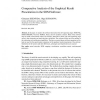Free Online Productivity Tools
i2Speak
i2Symbol
i2OCR
iTex2Img
iWeb2Print
iWeb2Shot
i2Type
iPdf2Split
iPdf2Merge
i2Bopomofo
i2Arabic
i2Style
i2Image
i2PDF
iLatex2Rtf
Sci2ools
INFORMATICALT
2002
2002
Comparative Analysis of the Graphical Result Presentation in the SOM Software
In the paper, we analyze the software that realizes the self-organizing maps: SOM-PAK, SOM-TOOLBOX, Viscovery SOMine, Nenet, and two academic systems. Most of the software may be found in the Internet. These are freeware, shareware or demo. The self-organizing maps assist in data clustering and analyzing data similarities. The software differs one from another in the realization and visualization capabilities. The data on coastal dunes and their vegetation in Finland are used for the experimental comparison of the graphical result presentation of the software. Similarities of the systems and their differences, advantages and imperfections are exposed. Key words: neural networks, SOM, mapping, visualization, correlation matrix, environmental parameters.
| Added | 22 Dec 2010 |
| Updated | 22 Dec 2010 |
| Type | Journal |
| Year | 2002 |
| Where | INFORMATICALT |
| Authors | Gintautas Dzemyda, Olga Kurasova |
Comments (0)

